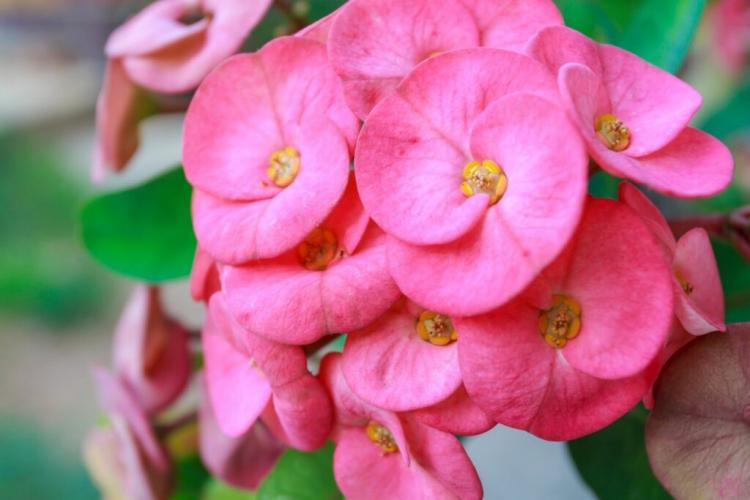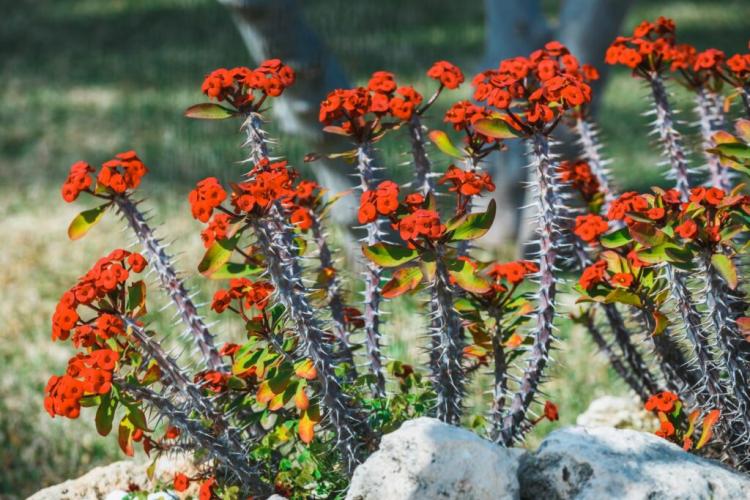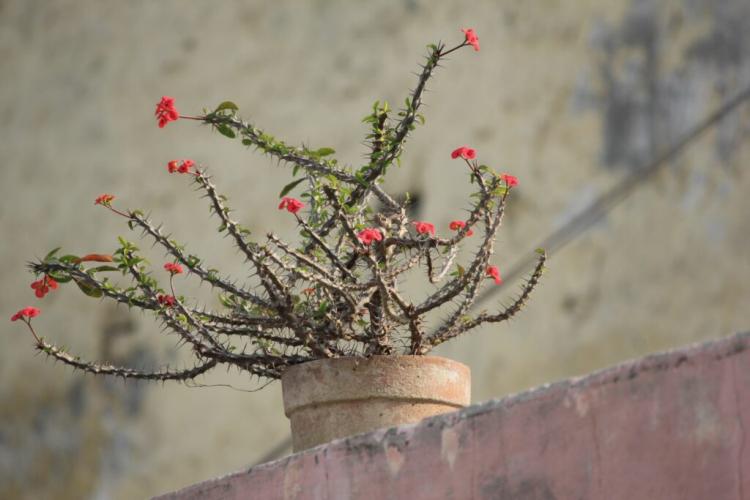Christ Thorn: Planting, Caring for & Propagating Euphorbia Milii
The Christ thorn (Euphorbia milii) is available in many colors and flowers not just once, but twice a year. Here you will find out, among other things, why the colorful splendor is actually not flowers at all.

Some Christthorn hybrids can bloom year round when grown indoors [Photo: unverdorben jr / Shutterstock.com]
The easy-care Christ thorn often blooms at Easter. In this article you will find out how you can get it to bloom abundantly and what else to consider when choosing a location and caring for the succulent.
Christ thorn: origin and characteristics
Table of Contents
The Christ thorn ( Euphorbia milii ) from the spurge family (Euphorbiaceae) originally comes from Madagascar and is also widely used as a houseplant. Like all species of the genus milkweed ( Euphorbia ), the parts of the plant contain a poisonous milky sap that escapes when injured. The succulent shrub can grow up to two meters in nature, but as a houseplant the growth ends at around 60 cm. Thorns sit on the fleshy shoots, which gave the Christ thorn, also known as the crown of thorns, its name. The green leaves, like the shoots, can store water. Euphorbia milii also has colored bracts that appear like flowers. The actual flowers are very small and inconspicuous and are surrounded by the bracts, which can be red, pink or white. But there are also varieties whose bracts are yellow, orange or even multicolored. The flowering period is usually between March and April, i.e. right on time for Easter. Some hybrids can even bloom all year round. Depending on when you order the crown of thorns to dry out, flowering can occur sooner or later.

What looks like petals are actually colored bracts [Photo: Jirayu13 / Shutterstock.com]
The most beautiful varieties
There are other varieties and hybrids of the species Euphorbia milii , some of which are also available in specialist plant shops. The Syrian Christ thorn is also known to many, although it is a completely different plant. The Syrian Christ thorn is a tree from the genus of the buckthorn family and is not kept as a houseplant. We briefly present some varieties and hybrids of Euphorbia milii here:
- Euphorbia milii 'Grandiflora': This is a hybrid from Thailand. The colored bracts are particularly large and appear light yellow with a pink border.
- Euphorbia x lomi 'Salmon': This is a pink- flowering variety of the hybrid Euphorbia x lomi, which arose from the species Euphorbia lophogona and Euphorbia milii. The initial syllables of the parent species are eponymous. The hybrid is evergreen and has large bracts.
- Euphorbia x lomi 'Sweet Heart': This variety is also one of the widespread indoor plant hybrids that keep their leaves in winter and bloom all year round. The 'Sweet Heart' variety develops pink bracts.
- Euphorbia milii var. Splendens : This variation is quite common as a houseplant. It can bloom in different colors and as a shrub can reach heights of two meters in nature.

Color gradients are also not uncommon [Photo: pittaya / Shutterstock.com]
Planting Christ thorn: location, soil and procedure
The Christ thorn is a houseplant that can also be spent outdoors in the summer. It is best to choose a location with a lot of light for the Christ thorn, because he likes it sunny. A south window with the midday sun does not bother him either and can even help him to have a greater display of flowers. When it is warm enough in summer, the Christ thorn can be put outside. It needs temperatures between 18 and 25 ° C during the growing season. It also prefers dry air, which is why it can thrive in heated rooms without additional air humidification.
Tip: The Christ thorn does not tolerate too high a humidity and it can lead to fungal diseases. Therefore, do not place the crown of thorns in the bathroom.

The shoots covered with thorns give the Christ thorn its name [Photo: Dziewul / Shutterstock.com]
The Christ thorn is not particularly demanding in terms of its substrate, but prefers a loose, permeable and not too wet soil. It is best to fill the bottom of the pot, which should definitely have a drainage hole, a layer of potsherds, expanded clay or stones. This ensures good water drainage and there is no waterlogging, which the Christ thorn cannot cope with particularly well. A mixture of potting soil and sand in a ratio of 2: 1 is suitable as a substrate. Our Plantura organic potting soil, for example, is an environmentally friendly base soil. It provides important nutrients for the Christ thorn and, with its compost content and loose structure, offers ideal conditions for the plant.
Plant Christ thorn outside
If you want to plant the Christ thorn outside, you should definitely keep it in a pot that you can put indoors in winter. In summer you can put Euphorbia milii outside without any problems, as long as the temperatures neither fall below 15 ° C at night nor rise above 30 ° C during the day. However, you should slowly get it used to the new outdoor location. That means, over a period of about two weeks, you put it in its new place for a few hours and then longer and longer. This should also be bright and sunny or partially shaded outside.
Care of the Christ thorn
Like all plants, the Christ thorn needs care, but is not particularly demanding here either. In any case, care should be taken with the care measures, as not only the thorns can lead to injuries, but also toxic milky sap escapes if the plant is injured. It is therefore advisable to wear gloves when cutting and repotting.

In summer Euphorbia milii can also be put outside [Photo: Mayuree Moonhirun / Shutterstock.com]
Water and fertilize Christ thorn
The Christ thorn does not need a lot of water. When the surface has dried out, you can water again, preferably with rainwater at room temperature or stale tap water. Even less water is needed in the cold season. Here the substrate can even dry out, but not over a long period of time. It should be watered from time to time so that magnificent flowers can appear in spring and the plant does not die. Any excess water in the saucer must be removed after watering, as the Christ thorn does not tolerate waterlogging.
One year after planting or repotting, the Christ thorn needs nutrients to continue growing. In the growing season between May and September you should add a liquid fertilizer to the substrate along with the irrigation water about every two weeks. For example, our Plantura organic indoor & green plant fertilizer is suitable, which is not only good for your plants, but also for the environment, as it primarily combines organic ingredients with the best effectiveness. It supplies your plants with important nutrients and beneficial microorganisms that support leaf and root growth.

Do not water until the substrate dries on the surface [Photo: MASTER PHOTO 2017 / Shutterstock.com]
Cutting Christ thorn
Cutting the Christ thorn is not necessary, but possible, as the plant is easy to cut. The best time to prune is in spring between March and April, but the crown of thorns can withstand pruning in the rest of the year. Use a sharp knife for this and be sure to wear gloves for protection. For a bushier growth, shorten the central main stem of the plant. Cut this off directly at the base – this is where new shoots will form, which branch out more strongly.
Tip: You can use cut shoots as cuttings to multiply the Christ thorn.
Repot Christ thorn
The crown of thorns is a rather slow growing plant. You can transplant the Christ thorn into a larger pot about every three years, but it should only be one or two sizes larger than the old pot. Too much space can mean that the plant cannot find a hold and there is too much substrate that could water. Be sure to wear gloves when repotting the Christ thorn. In the years between repotting, you can renew the top layer of the substrate. When repotting, a little flower fertilizer can also be added to increase the supply of phosphate in the soil.

In winter the leaves are often thrown off and then sprout again [Photo: Adarsh K Sharma / Shutterstock.com]
Christ thorn gets yellow leaves or loses leaves: causes and measures
If the Christ thorn gets yellow leaves or sheds them, there can be various causes.
- Natural leaf loss during the resting phase : If the Christ thorn sheds its leaves in winter, this is a natural process and a reaction to low temperatures and less water. There is no need to worry as the leaves will regrow in the following months. The resting phase is also important for the development of the flower buds.
- Location unsuitable : If the leaves turn yellow or are thrown off during the summer months, the location for the Christ thorn may be unsuitable. Then move it to another place that is sufficiently sunny and warm, preferably even outside in the fresh air, provided it is warm enough.
- Excess water : One of the common care mistakes that lead to leaf loss is excessive watering. If waterlogging occurs, the roots can rot and the leaves are thrown off. It is therefore essential to check the substrate. If it is too wet or there is even water in the saucer, repot the plant in fresh substrate.
Tip: Since the Christ thorn is somewhat sensitive to new light and temperature conditions, it may well happen that it sheds a few leaves after you have moved it. But these grow back quickly.

The plant also copes well with dry air [Photo: pittaya / Shutterstock.com]
Increase Christ thorn
Both seeds and cuttings are suitable for propagating the Christ thorn. However, the use of cuttings is more promising.
To do this, cut off an approximately 10 cm long shoot from a healthy plant with a sharp knife. Again, you should definitely wear gloves. The milky juice can be stopped by immersing the interface in lukewarm water for a while. The cutting should then dry for about two days before it is put into a mixture of potting soil and sand or special potting soil. Our Plantura organic herb & seed soil, for example, is suitable for growing plants, as it contains lower amounts of nutrients and thus promotes vigorous root growth in the seedlings. It does not contain peat, but is produced in a resource-saving manner, which also benefits the environment. After planting, the substrate should be kept evenly moist. Place the seed container in a bright place at temperatures above 20 ° C. After about a month, roots should have formed.

Propagation via cuttings is easy [Photo: SimplyAdrienne / Shutterstock.com]
Propagation by seeds is also possible. You can either buy these or collect them from the flowers after they have bloomed. Spread the seeds on moistened potting soil and cover them lightly with substrate. With this method, too, the place should be light and warm. Stretch cling film over the container to increase the humidity. After about a month, you should be able to see the seedlings. Then ventilate the foil every day before you remove it completely when the small plants have become too big for your mini greenhouse.
Hibernate crown of thorns
In order to produce flowers in spring, it is important to put the Christ thorn into a resting phase. To do this, the temperatures should be reduced to around 15 ° C in winter and less watering during this time – just enough so that the substrate does not dry out over the long term. Fertilizer applications are not required in the resting phase. Also, make sure that the Christ thorn only has about ten hours of light a day. After a successful hibernation, you should be able to enjoy the abundance of flowers in spring.

Hibernation is beneficial for blooming flowers in spring [Photo: Andri Seto Baskoro / Shutterstock.com]
Is Christ Thorn Poisonous?
The Christ thorn is poisonous because, like all plants of the genus milkweed, it contains a poisonous milky sap. This can lead to skin irritation. In addition, the shoots of the plant are equipped with numerous thorns, which can also cause injuries. Therefore, make sure that children and animals do not consume any parts of the Christ thorn and wear gloves during maintenance activities such as repotting and cutting.
Another blooming succulent is the Easter cactus. In our article you will find important care tips and interesting information about the popular houseplant.





